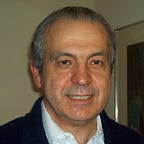The Magic Spaceship
The following “Magic Spaceship” is a geometrical shape that helps us to visualize 13 different ways in which the integer numbers 1 to 14 can be geometrically arranged to add up to the same magic number along four axes of symmetry: one horizontal, two slanted, and one vertical.
I named this magic figure “The Magic Spaceship”, because of its shape.
In the above figure, the central hexagon is the main body of the spaceship. The four wings, attached to the main body, support its four main propellers.
We now need to fill the triangular cells with the numbers 1 to 14, so that their sum, in any of the four directions, adds up to the same magic number.
If we are successful, our spaceship will travel forward, or backwards, along the four axes of symmetry, shown by the arrows in the figure below, and for each direction reach warp speed 35, our magic number.
Among several solutions, the following is the most “balanced”:
In addition, the tips of the propellers (white) add up to 35, and the back of the propellers (light blue) also add up to 35:
Furthermore, the propellers opposite to each other diagonally also add up to 35:
Finally, you may have noticed that the numbers in the body of the spaceship, the hexagon, also add up to 35.
As a reminder, the most basic 3 by 3 Magic Square has 9 square cells, and displays 8 ways in which the numbers 1 to 9 add up to 15.
Our Magic Spaceship has 14 triangular cells, and displays 13 ways in which its numbers, 1 to 14, add up to 35:
More Peculiarities of our Magic Spaceship Solution
We notice how the propellers are balanced respect to the vertical axis. That is, 8+9 = 4+13 and 6+12 = 7+11. However, the front propellers, at the top of the figure, are a bit lighter (each adding up to 17) than the back propellers (each adding up to 18). Since 35 is not divisible by 2, this is the most balanced pattern that can be achieved (17+18 = 35).
We notice a few more features within the hexagonal body:
— Four of its six triangles contain the first four prime numbers: 1, 2, 3, 5. The other two contain 10 (or 5 x 2) and 14 (or 7 x 2); the product of 5 and 7 is 35.
— The numbers in the hexagon further highlight the first multiples of 7:
— The numbers in the set of three non-contiguous triangles, 1, 10 and 3, add up to 14. This set, together with the triangle with number 14, the highest number, gives us a 28.
— The numbers in the two triangles non contiguous with 14, 2 and 5, add up to 7. Thus the numbers in the second set of three non contiguous triangles (14, 2 and 5) add up to 21.
— The five triangles of the hexagon, excluding the one containing number 14, (1, 2, 10, 5 and 3) also add up to 21.
— As mentioned, all the numbers in the hexagon add up to 35.
By cutting the hexagon in half, according to each of the two slanted axes, we again see the best possible 17/18 balance. In both cases, as for the propellers, the higher numbers (adding up to 18) are in the three triangles oriented towards the back (down).
— — —
If you would like to read about other magic figures, please see my article: The Magic Cross and Other Magic Figures.
